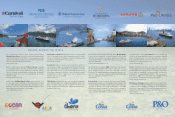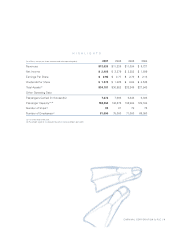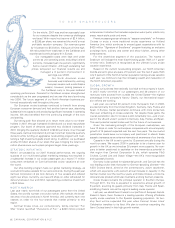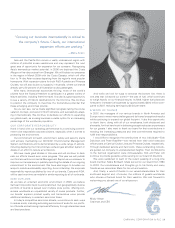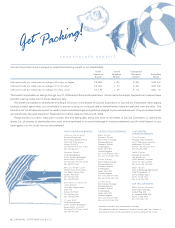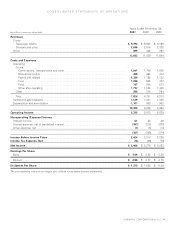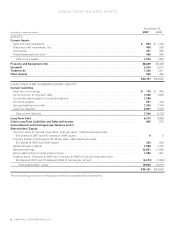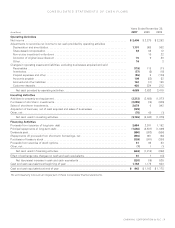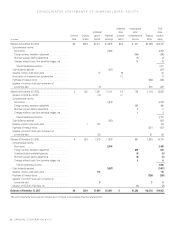Carnival Cruises 2007 Annual Report Download - page 13
Download and view the complete annual report
Please find page 13 of the 2007 Carnival Cruises annual report below. You can navigate through the pages in the report by either clicking on the pages listed below, or by using the keyword search tool below to find specific information within the annual report.
NOTES TO CONSOLIDATED FINANCIAL STATEMENTS (continued)
10 | CARNIVAL CORPORATION & PLC
NOTE 2— SUMMARY OF SIGNIFICANT
ACCOUNTING POLICIES
Basis of Presentation
We consolidate entities over which we have control (see
Notes 3 and 15), as typically evidenced by a direct ownership
interest of greater than 50%. For affiliates where significant
influence over financial and operating policies exists, as typi-
cally evidenced by a direct ownership interest from 20% to
50%, the investment is accounted for using the equity method.
Cash and Cash Equivalents and Short-Term Investments
Cash and cash equivalents include investments with matur-
ities of three months or less at acquisition, which are stated
at cost. At November 30, 2007 and 2006, cash and cash
equivalents are primarily comprised of money market funds,
time deposits and commercial paper.
As of November 30, 2007 and 2006, our short-term invest-
ments were not significant. Purchases and sales of short-term
investments included in our Consolidated Statements of Cash
Flows consisted of investments with original maturities greater
than three months with variable interest rates, which typically
reset every 28 days. Despite the long-term nature of their
stated contractual maturities, we generally had the ability to
quickly liquidate these securities and, accordingly, they are
considered short-term investments. All income generated from
these investments is recorded as interest income.
Inventories
Inventories consist of provisions, gift shop and art merchan-
dise held for resale, fuel and supplies carried at the lower of
cost or market. Cost is determined using the weighted-average
or first-in, first-out methods.
Property and Equipment
Property and equipment are stated at cost. Depreciation
and amortization were computed using the straight-line method
over our estimates of average useful lives and residual values,
as a percentage of original cost, as follows:
Residual
Values Years
Ships ............................. 15% 30
Ship improvements .................. 0% or 15% 3–28
Buildings and improvements . . . . . . . . . . 0–10% 5–35
Computer hardware and software ...... 0–10% 3–7
Transportation equipment and other . . . . 0–15% 2–20
Leasehold improvements, including
port facilities . . . . . . . . . . . . . . . . . . . . . Shorter of
lease term
or related
asset life
Ship improvement costs that we believe add value to our
ships are capitalized to the ships, and depreciated over the
improvements’ estimated useful lives, while costs of repairs
and maintenance, including minor improvement costs, are
charged to expense as incurred. We capitalize interest as part
of acquiring ships and other capital projects during their con-
struction period. The specifically identified or estimated cost
and accumulated depreciation of previously capitalized ship
components are written off upon replacement or refurbishment.
We review our long-lived assets for impairment whenever
events or changes in circumstances indicate that the carrying
amount of these assets may not be fully recoverable. The
assessment of possible impairment is based on our ability to
recover the carrying value of our asset based on our estimate
of its undiscounted future cash flows. If these estimated
undiscounted future cash flows are less than the carrying
value of the asset, an impairment charge is recognized for the
excess, if any, of the asset’s carrying value over its estimated
fair value.
Dry-dock costs primarily represent planned major mainte-
nance activities that are incurred when a ship is taken out of
service for scheduled maintenance. These costs are expensed
as incurred.
Goodwill
We review our goodwill for impairment annually, or, when
events or circumstances dictate, more frequently. All of our
goodwill has been allocated to our cruise reporting units. The
significant changes to our goodwill carrying amounts since
November 30, 2005 were the changes resulting from using
different foreign currency translation rates at each balance
sheet date, the addition of $161 million of Ibero Cruises good-
will in fiscal 2007 (see Note 15), and the $20 million reduction
to goodwill in fiscal 2006 resulting from the resolution of
certain P&O Princess Cruises plc’s (“P&O Princess”) tax
contingency liabilities that existed at the time of the DLC
transaction.
Our goodwill impairment reviews consist of a two-step
process of first determining the fair value of the reporting unit
and comparing it to the carrying value of the net assets allo-
cated to the reporting unit. Fair values of our reporting units
were determined based on our estimates of market values. If
this fair value exceeds the carrying value, which was the case
for our reporting units, no further analysis or goodwill write-
down is required. If the fair value of the reporting unit is less
than the carrying value of the net assets, the implied fair value
of the reporting unit is allocated to all the underlying assets and
liabilities, including both recognized and unrecognized tangible
and intangible assets, based on their fair value. If necessary,
goodwill is then written down to its implied fair value.


